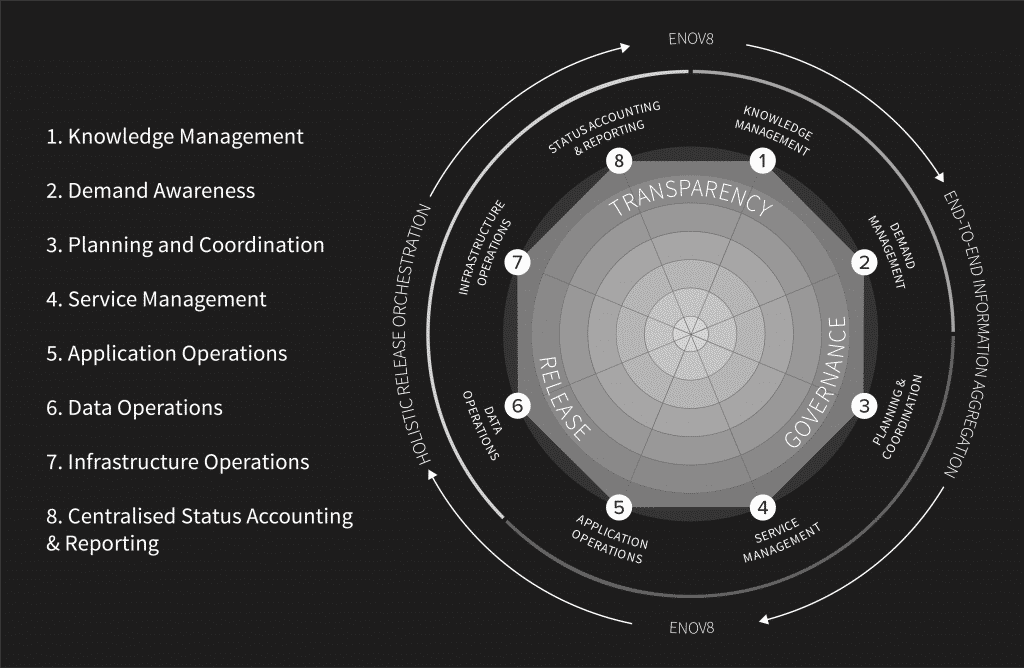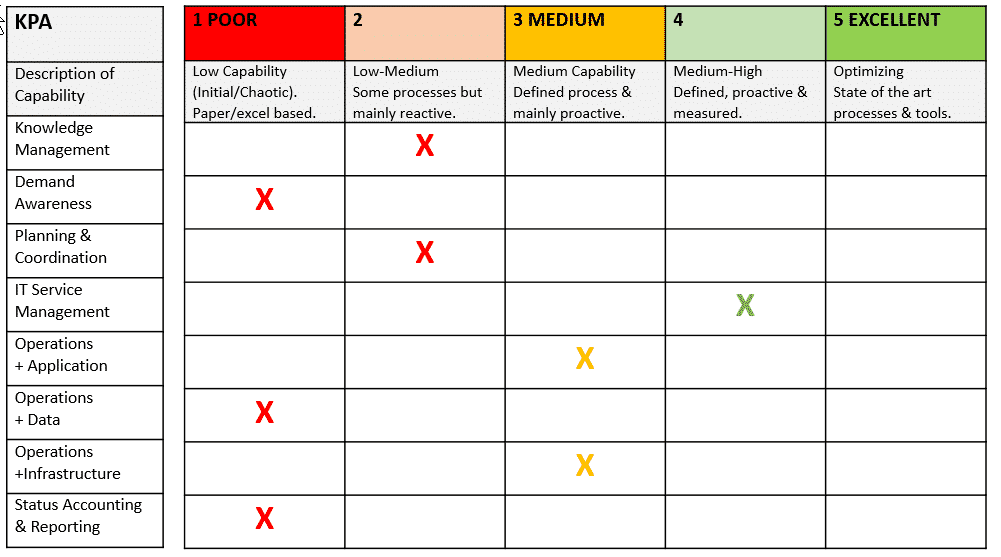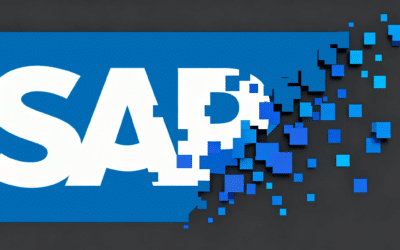Environment Management Maturity index Assessment – enov8
by Niall Crawford
Well here at Enov8, over the last few years, we have been building a model called the EMMi (the Environment Management Maturity Index)
Originally called the TEMMi , the EMMi is designed to help organisations understand the big picture, openly discuss capabilities using a standard “frame of reference” and quickly assess themselves i.e. Identify Strengths, Weaknesses, Opportunities and Threats.
The EMMi (Environment Management Maturity Index) can be broken into following eight Key Performance Areas:

(Find the PDF here)
So how do you rate?
Follow the methodology below & use the online maturity calculator to generate yourself a spider diagram baseline report.
EMMi – Score Card
Consider each of the eight Key Performance Area (KPA) from a People (skilling), Process (Repeatability) & Product (Tooling perspective) and score yourself from 1-5.

1. Environment Knowledge Management:
Understanding your IT environments across the lifecycle i.e. across Projects Delivery (e.g. Development, Test, Training) & Production. Without effective intelligence, you will struggle to manage your environments effectively. Intelligence mapping is both top down & bottom up i.e. Top down included understanding Businesses Units, Business Processes, Systems relationships, while Bottom up looks at from the other direction i.e. Components, Interfaces & Instances. Score yourself:

2. Environment Demand Awareness
There is a reason you have these environments, they’re called your consumers (Project Teams, DevTest Teams etc). The ability to understand demand and current usage of one’s IT Environments and shift planning & coordination left. Score yourself:

3. Environment Planning & Coordination
The proactive planning & coordination of environment events & deployments ensures your systems are provided in a timely fashion and ems are correctly configured i.e. fit for purpose and available. Score yourself:

4. Environment IT Service Management
IT Service Management is a customer-focused approach to delivering & supporting information technology. Key aspects of ITSM support include management of Incidents, Change and Releases. ITSM, although potentially leaner, is relevant even in Non-Production as it controls the chaos, invisible change and avoids disruption. Score yourself:

5. Application Release Operations
The implementation of consistent, repeatable & traceable application release operations contributes to the broader needs of IT Environment Management and IT delivery. At a minimum, you should be promoting standard operating procedures & ideally tracking these & automating the most time-consuming tasks. Score yourself:

6. Data Release & Privacy Operations
The implementation of consistent, repeatable & traceable data release operations contributes to the broader needs of IT Environment Management and IT delivery. At a minimum, you should be promoting standard operating procedures & ideally tracking these & automating the most time-consuming tasks. Score yourself:

7. Infrastructure & Cloud Release Operations
The implementation of consistent, repeatable & traceable infrastructure & cloud release operations contributes to the broader needs of IT Environment Management and IT delivery. At a minimum, you should be promoting standard operating procedures & ideally tracking these & automating the most time-consuming tasks. Score yourself:

8. Status Accounting & Reporting:
The ability to capture and present “real-time” environment information in a way that will uplift IT environment analytics, decision making and continual optimization. At any point in time you should be able to visualise Environment Topology, Usage, Health, Activities, Operational Behaviour and System Team Competence. Score yourself:

Want to learn more about how to improve each of the Environment dimensions?
If you are interested in learning more about implementing a mature Environment Management framework in your organisations then speak to enov8 about enov8 Environment Manager. Enov8 Environment Manager is the only complete platform that takes you across the Environment Management & Release Spectrum.
Niall is the Co-Founder and CIO of Enov8. He has 25 years of experience working across the IT industry from Software Engineering, Architecture, IT & Test Environment Management and Executive Leadership. Niall has worked with, and advised, many global organisations covering verticals like Banking, Defence, Telecom and Information Technology Services.
Relevant Articles
Enterprise Release Management: A Comprehensive Guide
Enterprise Release Management (ERM) is a set of end-to-end practices that enable large organizations to effectively manage software releases. ERM is uniquely designed for the challenges of multiple teams building and releasing software simultaneously. ERM establishes...
Your Essential Test Environment Management Checklist
“Test Environment Management Checklist.” Yep, that sounds like a mouthful, but don’t let that discourage you. The idea here is quite simple—adopting a checklist to evaluate the soundness of your test environment management approach. Even though the idea sounds simple...
A Detailed Guide to SAP Data Masking
SAP systems handle some of the most sensitive data in the enterprise: financial transactions, HR information, supplier records, customer profiles, operational details, and more. For that reason, copying production data into non-production systems without modification...
Release vs Deployment Management: What’s the Difference?
In the always-an-adventure world of IT service management, there are several key processes that are essential for delivering high-quality services to customers and end-users. Two of the most critical processes are release management and deployment management....
7 Tools to Help with Application Rationalization
Application rationalization is the process of identifying which applications an organization should keep, update, consolidate, or retire. Think of it as a financial adviser, but instead of your investment portfolio, it's your application portfolio. Most companies take...
Pairing DevOps with Test Environment Management
For many organizations, DevOps is the best practice for efficiency. However, this model doesn’t come easily as the organization needs to put certain things in place. For example, the firm needs to incorporate the right tools to ensure its delivery pipeline and...






